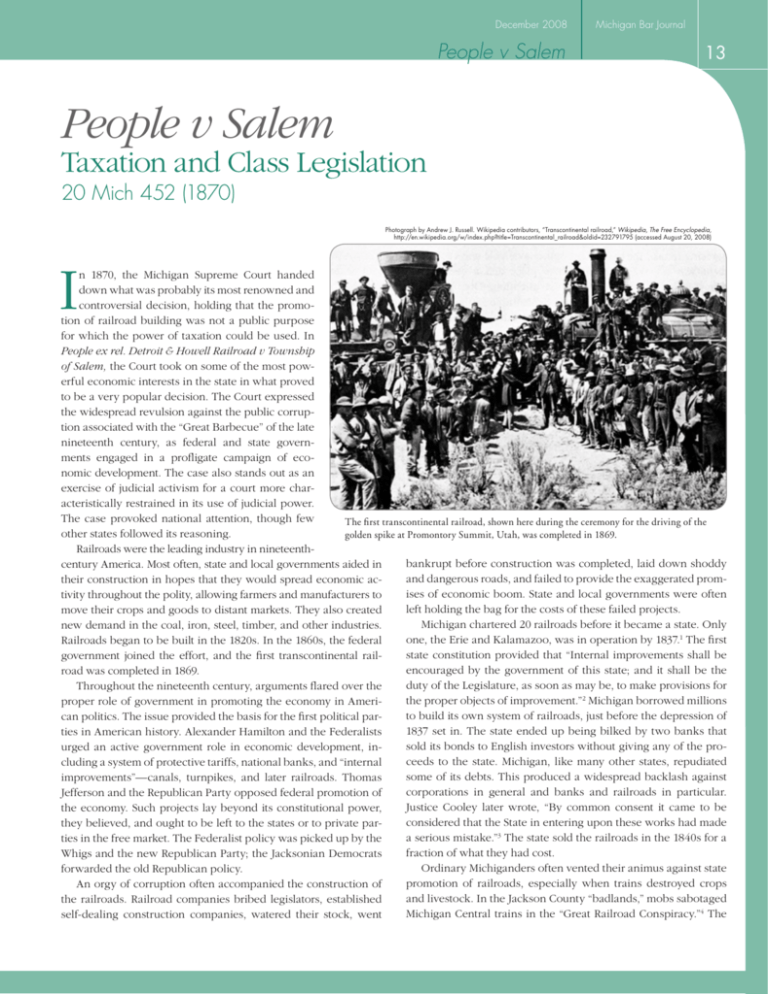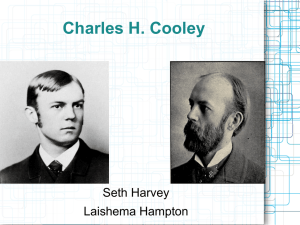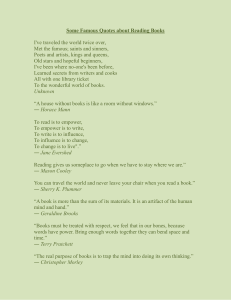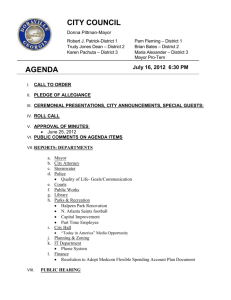People v Salem - Michigan Supreme Court Historical Society
advertisement

December 2008 People v Salem Michigan Bar Journal 13 People v Salem Taxation and Class Legislation 20 Mich 452 (1870) Photograph by Andrew J. Russell. Wikipedia contributors, “Transcontinental railroad,” Wikipedia, The Free Encyclopedia, http://en.wikipedia.org/w/index.php?title=Transcontinental_railroad&oldid=232791795 (accessed August 20, 2008) I n 1870, the Michigan Supreme Court handed down what was probably its most renowned and controversial decision, holding that the promotion of railroad building was not a public purpose for which the power of taxation could be used. In People ex rel. Detroit & Howell Railroad v Township of Salem, the Court took on some of the most powerful economic interests in the state in what proved to be a very popular decision. The Court expressed the widespread revulsion against the public corruption associated with the “Great Barbecue” of the late nineteenth century, as federal and state governments engaged in a profligate campaign of economic development. The case also stands out as an exercise of judicial activism for a court more characteristically restrained in its use of judicial power. The case provoked national attention, though few The first transcontinental railroad, shown here during the ceremony for the driving of the other states followed its reasoning. golden spike at Promontory Summit, Utah, was completed in 1869. Railroads were the leading industry in nineteenthbankrupt before construction was completed, laid down shoddy century America. Most often, state and local governments aided in and dangerous roads, and failed to provide the exaggerated promtheir construction in hopes that they would spread economic acises of economic boom. State and local governments were often tivity throughout the polity, allowing farmers and manufacturers to left holding the bag for the costs of these failed projects. move their crops and goods to distant markets. They also created Michigan chartered 20 railroads before it became a state. Only new demand in the coal, iron, steel, timber, and other industries. one, the Erie and Kalamazoo, was in operation by 1837.1 The first Railroads began to be built in the 1820s. In the 1860s, the federal state constitution provided that “Internal improvements shall be government joined the effort, and the first trans­continental railencouraged by the government of this state; and it shall be the road was completed in 1869. duty of the Legislature, as soon as may be, to make provisions for Throughout the nineteenth century, arguments flared over the the proper objects of improvement.”2 Michigan borrowed millions proper role of government in promoting the economy in Amerito build its own system of railroads, just before the depression of can politics. The issue provided the basis for the first political par1837 set in. The state ended up being bilked by two banks that ties in American history. Alexander Hamilton and the Federalists sold its bonds to English investors without giving any of the prourged an active government role in economic development, inceeds to the state. Michigan, like many other states, repudiated cluding a system of protective tariffs, national banks, and “internal some of its debts. This produced a widespread backlash against improvements”—canals, turnpikes, and later railroads. Thomas corporations in general and banks and railroads in particular. Jefferson and the Republican Party opposed federal promotion of Justice Cooley later wrote, “By common consent it came to be the economy. Such projects lay beyond its constitutional power, considered that the State in entering upon these works had made they believed, and ought to be left to the states or to private para serious mistake.”3 The state sold the railroads in the 1840s for a ties in the free market. The Federalist policy was picked up by the fraction of what they had cost. Whigs and the new Republican Party; the Jacksonian Democrats Ordinary Michiganders often vented their animus against state forwarded the old Republican policy. promotion of railroads, especially when trains destroyed crops An orgy of corruption often accompanied the construction of and livestock. In the Jackson County “badlands,” mobs sabotaged the railroads. Railroad companies bribed legislators, established Michigan Central trains in the “Great Railroad Conspiracy.”4 The self-dealing construction companies, watered their stock, went The Verdict of History 14 THE FORMATIVE YEARS: 1858–1870 Supplement from the Michigan Supreme Court Historical Society People v Salem 1850 constitution limited the state’s role in promoting internal improvements. It stated that, “The state shall not be a party to, nor interested in, any work of internal improvement, nor engaged in carrying out any such work.” It allowed municipalities to do so, but limited the amount of debt that they could incur in such projects.5 “These were very positive provisions,” Justice Cooley later wrote, “and by adopting them the people believed they had rendered it impossible that projects of doubtful wisdom and utility should be engaged in at public cost.”6 Michigan was a solidly democratic state from its admission to the Union until the mid-1850s. As such, its leaders had always opposed federal promotion of internal improvements. Under the 1835 constitution, the Democrats eagerly embraced state promotion. Under the 1850 constitution, improvements were left to town and county governments, within limits. The general principle to which the Jacksonian Democrats appealed was that public power should only be used for genuinely public purposes. This was one of the oldest ideas in the history of western civilization: that in a republic, government concerned itself only with public things— res publica, the good of the whole. Monarchs and aristocrats often used public power for their own ends, but democratic majorities—or well-organized minorities—were also capable of using public power for private interests. Thus, republican or democratic government depended on constitutional safeguards against all such partial or “class legislation.” James Madison gave classic expression to this idea in Federalist 10, and the federal Constitution withheld certain powers from the states (enacting laws that impaired the obligation of contracts, for example). Most states went further and enacted their own constitutional limitations. In 1864, the Michigan legislature enacted a law permitting several townships located in the counties of Livingston, Oakland, Washtenaw, and Wayne to pledge their credit for the construction of a railroad from Detroit to Howell.7 Salem electors, upon a majority vote at a special town meeting, did so, and the track was built, but the township board then refused to issue the bonds to pay for the construction. The railroad company sued, seeking a writ of mandamus ordering the township to issue the bonds and tax its residents to redeem them in accordance with the state statute. There were several questions about the procedures that the Image courtesy of Salem Area Historical Society, P.O. Box 75011, Salem, MI 48175 This photo of the Salem depot and elevator was taken around the time of the Salem case. state followed in this case. Serious doubt existed as to the constitutionality of the 1864 act, as well as the vote taken by the Salem township board. While the Michigan legislature insisted that both were constitutional and regular, the voters of the state rejected a constitution proposed in 1867 to make such acts easier.8 The Salem case consumed eight days of argument before the Supreme Court in April and May 1870. The attorneys for Salem pointed to the sections of the Michigan Constitution that prohibited state aid for internal improvements, and noted that the constitution required a two-thirds supermajority for local aid bills. The act was “not a law, but an attempted license to an act of spoliation,” they claimed, “an imperial edict or ukase,” and “a forced loan or donation to a railroad company.”9 They also noted the unhappy experience with railroad promotion that led to the 1850 constitution, and remarked that “in most of the states where municipal subscription to railroad stock has been maintained by the courts, the revulsion of public sentiment has been so strong as to lead to prompt prohibitory constitutional amendments.”10 The railroad, however, claimed that no provision of the constitution explicitly prohibited such aid, and insisted that, for a court to declare a legislative act unconstitutional, the act “must be prohibited by the express words of the constitution, or by necessary implication,” thus appealing to the self-restraint so often shown by the Court.11 Public aid to private corporations for internal improvements was acceptable if the enterprise was “in the least degree of a public nature, or bears any relation to the public prosperity.” The railroad claimed that the railroad was such a public benefit, and “benefit to the corporation is merely an indirect and collateral result.” Nearly every other state court and the United States Supreme Court had upheld such acts.12 The case did not turn on these arguments, however. Each justice wrote an opinion. Justices Campbell and Christiancy concurred with Justice Cooley’s sweeping majority opinion, which cut to the very heart of the relevant constitutional principles. The power of taxation could only be exercised for public purposes, Cooley noted, and must be fairly apportioned. These were “fundamental maxims in the law of taxation. They inhere in the power to impose any taxes whatsoever,” regardless of the specific provisions of the Constitution.13 Thus, Cooley’s opinion rested not on the text of the Constitution, but on basic principles of justice and taxation. Cooley and other judges of that era believed that there were important substantive principles behind the concrete, textual provisions of a constitution. This idea was something like the ancient and medieval idea of “natural law,” and came to be called “substantive due process.” In short, the idea was that some rights were so fundamental that the government could not abridge them even with ordinary process of law. Cooley had recently published the first edition of his famous treatise, Constitutional Limitations, which made this argument more fully. In the years 1890–1937, when federal and state courts struck down “progressive” legislation regulating business, they often cited Cooley’s treatise. He thus acquired a reputation as the father of “laissez-faire” constitutionalism. In recent years, however, historians have shown that the progressives exaggerated December 2008 Michigan Bar Journal People v Salem 15 Image courtesy of the Michigan State Supreme Court Historical Society Cooley was certainly the biggest of the Big Four in terms of national reputation. He was best known as a writer of legal treatises, most especially his 1868 Treatise on the Constitutional Limitations Which Rest Upon the Legislative Powers of the States of the American Union. It went through five editions in his lifetime and influenced more than a generation of lawyers and scholars. He also taught at the University of Michigan Law School from 1859 until 1884. Official court portrait of Justice Thomas M. Cooley Like the other Big Four, Cooley was born in New York—in Attica. When Cooley was born, Attica sat at the western end of the nearly completed Erie Canal, which served as the gateway to the Midwest for thousands of families like the Cooleys, of ­seventeenth-century New England Puritan lineage. Like the great United States Chief Justice John Marshall, Cooley was one (the tenth) of fifteen children. His family faced straitened circumstances, if not dire poverty.1 Cooley left New York in 1843. Chicago was his destination, but he ran out of money and finally settled in Adrian, Michigan. The frontier world that he found there reminded him of his own origins in western New York. A rude log cabin for a home, and the bare necessities of life for their families contented them while they were clearing their lands; and the lessons of industry and economy would have been forced upon them by the situation even if they had not learned them before, as many of them had…. Hard labor and the chills of fever incident to the clearing of a new country gave them sallow complexions and made them prematurely old; but in coming [West]…they had calculated not so much upon their own immediate advantage as upon giving their children an opportunity “to group up with the country”; and they accomplished all they had counted on if they could see that year by year their possession increased in value, and could rely with confidence upon giving their children the rudiments of education and a fair start in the world, and on being independent in their circumstances in their old age. Even now, though they could not supply all their wants from their farms, they contracted few debts, but postponed purchases when they had nothing to barter for the articles they desired.2 Cooley here expressed the pioneering spirit of the American dream and “Protestant” work ethic that predominated in Victorian American culture. By hard work, of a kind that one of his children said amounted to a “narcotic” for him, Cooley rose slowly but surely in society.3 Cooley helped to improve the legal practice of Michigan, which he perceived as rather primitive. Michigan, Cooley wrote, “had its full share of lawyers, many of whom were well trained in their profession, and would be a credit to it anywhere.” But, he continued, “Others were untrained, unlettered, and unkempt, and their vulgarity and insolence would be tolerated nowhere but in the woods. They tried small cases for smaller pay on still smaller knowledge, and were never so well satisfied as when they gained a suit by a trick.”4 He became a lawyer and edited a magazine, became active in antislavery politics, and was selected to compile Michigan’s statutes and to be the first reporter for the Cooley’s 1868 Treatise new Supreme Court. on the Constitutional 1. Jones, The Constitutional Conservatism of Thomas McIntyre Cooley: A Study in the History of Ideas (Garland Publishing, 1987), depicts the Cooleys in middling conditions; Reed, Bench and Bar of Michigan: A Volume of History and Biography (Chicago: Century Pub and Engraving Co, 1897), p 227, describes harsher circumstances. 2. Quoted in Carrington, Law as ‘the common thoughts of men’: The law-teaching and judging of Thomas McIntyre Cooley, 49 Stanford L R 504 (1997). 3. Jones, supra. 4. Cooley, Michigan: A History of Governments (Boston: Houghton Mifflin, 1895), p 248. the extent of such judicial use of substantive due process, and wrongly attributed it to Cooley. Far from being a defender of big business, Cooley reflected the antebellum Jacksonian animus against monopoly, special privilege, and class legislation.14 Cooley did not deny that railroads benefited the public, or that they were subject to public regulation as “common carriers,” or even that it was constitutional to use the power of eminent domain in their construction. But the Detroit and Howell Railroad Company was privately owned; the public did not own shares in the company, partake of its management, or share in its profits. The public benefits that the railroad provided were incidental byproducts of private enterprise—as indeed all useful business activity produced. “The incidental benefit which any enterprise may bring to the public, has never been recognized as sufficient of itself to bring the object within the sphere of taxation,” he wrote.15 Cooley denied that the legality of such railroad aid was settled. “The best judgment of the legal profession, so far as I have been Limitations Which Rest Upon the Legislative Powers of the States of the American Union went through five editions in his lifetime. able to judge, has always been against the lawfulness of this species of railroad aid,” he wrote, and opposition was growing.16 The Court denied the Detroit and Howell Railroad Company’s request for a mandamus. “The case before us is that of a private corporation demanding a gratuity,” Cooley concluded, and the state had no power to enforce such a demand. Justices Christiancy and Campbell concurred with Cooley’s fundamental point that, as Campbell put it, “taxation for private purposes is no more legal than robbery for private purposes.”17 The decision amounted to a sharp blow against state abuse of the “police power”—the general power to legislate on matters of public health, safety, welfare, and morals. Justice Graves, however, entered a lengthy dissent. He primarily took issue with the majority’s use of judicial power, in a doubtful case, to overturn a legislative act. “The judiciary has no preeminent claim to infallibility,” he warned, saying that republican government relied primarily on representation and diffusion of The Verdict of History 16 THE FORMATIVE YEARS: 1858–1870 Supplement from the Michigan Supreme Court Historical Society People v Salem power in the political branches to prevent the abuse of power.18 A constitutional violation had to be patent, obvious, and manifest, he argued, for the Court to overturn it. Moreover, the majority’s admission that railroads could use the power of eminent domain showed that they were, to some degree, public bodies. The decision caught the nation’s attention, and sparked a firestorm of controversy. It seemed to defy a United States Supreme Court decision in the 1864 case of Gelpke v Dubuque, which held that a city had to redeem bonds that it had issued in excess of a state constitutional limitation.19 Michigan Governor Henry P. Baldwin warned that it rendered worthless millions of dollars of bonds issued by other Michigan townships. Railroads were alarmed, and legal scholars noted the decision’s bold departure from text and precedent. But the decision was popular among voters, who condemned the power and corruption of railroads.20 Michigan Democrats rallied around the decision, and gained seats in the 1870 elections. Cooley reaffirmed the holding the next year.21 Nevertheless, other state courts did not follow the principles of Salem.22 Nor did the federal courts, which in these years enforced state and local obligations to pay railroad bonds already issued.23 At the same time, the United States Supreme Court upheld widespread use of state “police power” to promote and regulate the economy.24 The federal courts held that Michigan and other states had to redeem such bonds held by out-ofstate citizens.25 The United States Supreme Court did affirm Coo­ ley’s fundamental point that states could use taxation only for public purposes, but it assumed that railroads were public purposes.26 It was not until the 1890s, and then not directly, that the broad libertarian principles of Salem acquired some influence. In later years, Cooley reflected his pride in the decision. Political agitation to overturn the decision failed, he observed, “and the excitement soon died out. The people had taken the ‘sober second thought.’”27 But Cooley suffered from the political fallout of the decision, which angered the pro-railroad Republicans. Cooley drifted away from the party, like many who called themselves “liberal Republicans” in the 1870s, and eventually returned to the Democratic Party. He thus lost what would otherwise have been an excellent chance to be appointed to the United States Supreme Court.28 In 1885, Cooley lost a bitter re-election bid, largely because of the enmity of the Detroit Free Press and News. Notwithstanding the Salem decision, the News claimed that Cooley was pro-corporation and pro-railroad, and denounced him as “the acute casuist, the ingenious sophist, the second Francis Bacon.” In fact, the yellow-journalistic News launched this demagogic campaign against Cooley as vengeance for a libel judgment against the paper that the Supreme Court had upheld.29 The election was “one of those inexplicable convulsions of the popular vote that will now and then deprive the state of the services of its ablest citizens,” a legal commentator observed in 1890.30 Two years after the election, President Grover Cleveland made Cooley the first chairman of the Interstate Commerce Commission, created by Congress to regulate railroads. Having lost the battle to stem the public promotion of privileged corporations, Cooley now had the chance to begin their public control. Justice Christiancy left the Court for the U.S. Senate in 1875 and Justice Graves retired in 1883. Only Justice Camp­bell remained of the “Big Four” after Cooley’s 1885 defeat. Salem displayed the political independence of the Michigan Supreme Court under these justices, a trait that contributed greatly to its eminent reputation. The questions of the limits of legislative power and the exercise of judicial review, which prompted Graves’ dissent, are inevitable in any system of democratic government with an independent judiciary. We are no closer today to providing easy answers to these questions than Cooley was. FOOTNOTES 1. Dunbar, Michigan: A History of the Wolverine State, 2d ed. (Grand Rapids: Eerdmans, 1970), p 330. 2. Const 1835, art XII, §3. 3. Dunbar, supra at 340; Cooley, Michigan: A History of Governments, 7th ed (Boston: Houghton Mifflin, 1895), p 290. 4. Hershock, The Paradox of Progress: Economic Change, Individual Enterprise, and Political Culture in Michigan, 1837–1878 (Athens: Ohio Univ Press, 2003), pp 42, 47, 81; Ladd, The Michigan Central Railroad Conspiracy Trial of 1851, American Law Review 24 (1890), p 98. 5. Const 1850, art XIV, §9; Const 1850, art IV, §49. 6. Cooley, supra at 292. 7. The law was Act No. 49, entitled “an act to authorize the several townships in the counties of Livingston, Oakland, Washtenaw, and Wayne, to pledge their credit, and the County of Livingston to raise by tax a loan of money to aid in the construction of a railroad from some point near the city of Detroit to Howell, in the County of Livingston.” 8. People ex rel. Detroit & Howell Railroad Co v Township of Salem, 20 Mich 452, 472 (1870); Jones, Thomas M. Cooley and the Michigan Supreme Court, 1865–85, American Journal of Legal History 10 (1966), p 102. 9. Salem, supra at 453–460. 10. Id. at 460. 11. Id. at 461. 12. Id. at 463, 468 (emphasis added). 13. Id. at 474–475, 495; Chaney, The Supreme Court of Michigan, Green Bag 2 (1890), p 397. 14. Urofsky, Myth and Reality: The Supreme Court and Protective Legislation in the Progressive Era, Supreme Court Historical Society Yearbook (1983); Jones, supra; Wise, “The Ablest State Court”: The Michigan Supreme Court Before 1885, 33 Wayne L R 1509, 1540 (1987). 15. Salem, supra at 488. 16. Id. at 493. 17. Id. at 495. 18. Id. at 503. 19. Gelpcke v City of Dubuque, 68 US 175; 17 L Ed 520 (1864). 20. Dunbar & May, Michigan: A History of the Wolverine State, 3d ed (Grand Rapids: Eerdmans, 1995), p 370. 21. People ex rel. Bay City v State Treasurer, 23 Mich 499 (1871). 22. Carrington, Law as “the Common Thoughts of Men”: The Law-Teaching and Judging of Thomas McIntyre Cooley, Stanford L R 49, 542–543 (1997); Jones, supra at 105. 23. Gelpke, supra. 24. Slaughter-House Cases, 83 US 86; 21 L Ed 394 (1873); Munn v Illinois, 94 US 113; 24 L Ed 77 (1877). 25. Taylor v Ypsilanti, 105 US 60; 26 L Ed 1008 (1881); Pine Grove v Talcott, 86 US 666; 22 L Ed 227 (1873). Some Michigan courts nevertheless continued to abide by Salem. See Wendell, Relations Between the Federal and State Courts (New York, 1949), p 159 and Freyer, Harmony and Dissonance: The Swift and Erie Cases in American Federalism (New York: New York Univ Press, 1981). 26. Loan Association v Topeka, 87 US 655; 22 L Ed 455 (1872). 27. Cooley, supra at 293. 28. Jones, supra at 107. 29. Edwards, Why Justice Cooley left the bench: A missing page of legal history, 10 Wayne L R 490 (1964). 30. Chaney, The Supreme Court of Michigan, Green Bag 2 (1890), p 391.








